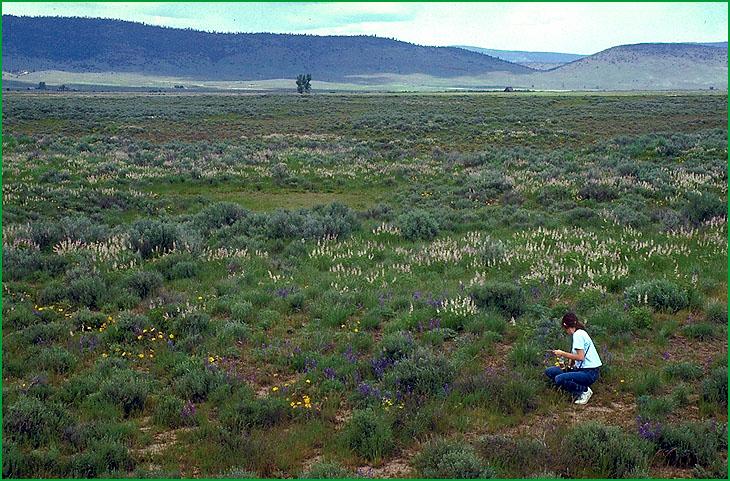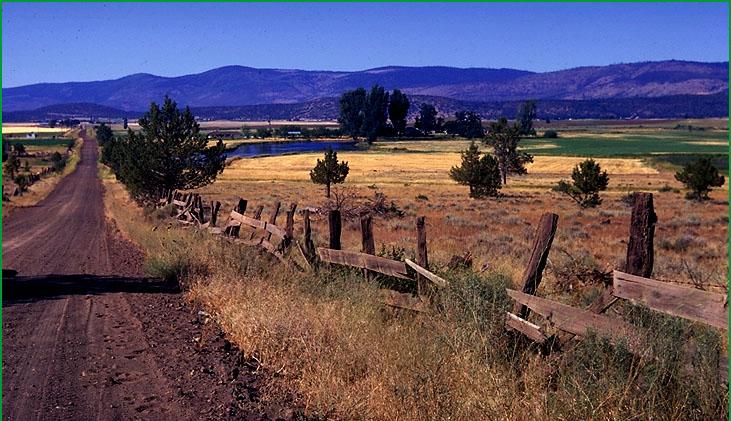 | Big Valley Mountains-Big Valley-Fall River Valley |
Big Valley-Subsection M261Gp, Big Valley area Ś James R. Nelson |
Fall River Valley-Subsection M261Gp, Pit River area in Fall River valley Ś Robert Ettner |
http://www.fs.fed.us/r5/projects/ecoregions/m261gn.htm
Subsection M261Gn
Big Valley Mountains
This subsection consists of mountains northeast of Fall River Valley and west of Big Valley. The climate is temperate to cold and subhumid. MLRA 22d.
Lithology and Stratigraphy. The bedrock is predominantly Tertiary basalt, with lesser amounts of Pleistocene basalt. Recent ash fall has influenced soil development. There are some alluvial deposits in small valleys. Most faults are aligned toward the northwest or the north-northwest.
Geomorphology. The main landforms are two mountain blocks that are steep on one side and gently sloping to moderately steep on the other side. The Big Valley Mountains block is steep on the southwest side and the Indian Spring Mountain block is steep on the west-southwest side. Jimmerson Mountain appears to be an eroded shield volcano. There are few cinder cones. There are alluvial fans and basin-fill on valley floors. The elevation range is from about 3700 feet up to 6321 feet on Widow Mountain. Faulting, fluvial erosion, and freeze-thaw are the main geomorphic processes.
Soils. Soils are mostly Lithic, Lithic Ultic, and Ultic Argixerolls; Lithic, Andic, and Ultic Haploxeralfs; Typic Haploxerands; Alfic Vitrixerands; Vitrandic Palexeralfs; and Abruptic Argiduridic and shallow Argiduridic Durixerolls. The soils are well drained on upland. Soil temperature regimes are mesic and frigid. Soil moisture regimes are mostly xeric, but some are aridic in and around valleys.
Vegetation. The predominant natural plant communities are Ponderosa pine and Mixed conifer series in the northern and central parts and Western juniper series and Big sagebrush series in the southern part of the subsection. White fir series is present at the higher elevations. Low sagebrush series occurs on shallow soils.
Characteristic series by lifeform include:
Grasslands: Ashy ryegrass series, California oatgrass series, Creeping ryegrass series, Idaho fescue series, Indian ricegrass series, Nebraska sedge series, Needle-and-thread series.
Shrublands: Big sagebrush series, Bitterbrush series, Black sagebrush series, Low sagebrush series, Parry rabbitbrush series, Rubber rabbitbrush series.
Forests and woodlands: Aspen series, Curlleaf mountain-mahogany series, Oregon white oak series, Western juniper series, Ponderosa pine series, White fir series.
Climate. Mean annual precipitation is about 20 to 30 inches. Much of the precipitation is snow. Mean annual temperature is about 42░ to 50░ F. The mean freeze-free period is in the range from 75 to 125 days.
Surface Water. Runoff from uplands is rapid; much of it drains down through joints in the basalt to the ground water reservoir, limiting overland flow of water and development of stream channels. There are few streams and many of those are dry during summer. Streams drain to the Pit River, which runs around the southern end of the subsection, to tributaries of the Pit River, or to small closed basins northeast of the subsection.
Subsection M261Go
Big Valley
This subsection consists of the Big Valley alluvial - lacustrine plain. It is between the Big Valley and the Adin Mountains. The climate is temperate and semi-arid to subhumid. MLRA 21e.
Lithology and Stratigraphy. The subsection consists mainly of nonmarine Pliocene and Pleistocene sedimentary basin deposits, Pleistocene basalt, and late Quaternary lacustrine and alluvial deposits.
Geomorphology. The landform is a plain that is nearly level on lake floor and floodplains and very gently to moderately sloping on older deposits. The elevation range is about 4100 to 4200 feet. Fluvial erosion and deposition and freeze-thaw are the main geomorphic processes.
Soils. Soils on basalt and sedimentary deposits are mostly Lithic and Ultic Argixerolls and shallow Argiduridic and shallow Abruptic Argiduridic Durixerolls. Those on lake floors and floodplains are mostly Aquic Haploxerolls, Typic Chromoxererts, Xeric Endoaquerts, and Typic Haplaquands. The soils are well to poorly drained. Soil temperature regimes are mesic. Soil moisture regimes are aridic, xeric, and aquic.
Vegetation. The predominant natural plant communities are Low sagebrush series, Silver sagebrush series, and Sedge meadow communities.
Characteristic series by lifeform include:
Marshes: Bulrush series, Bulrush - cattail series, Cattail series.
Grasslands: Alkali sacaton series, Ashy ryegrass series, Common reedgrass series, Creeping ryegrass series, Idaho fescue series, Indian ricegrass series, Needle-and-thread series, Pickleweed series, Saltgrass series.
Shrublands: Big sagebrush series, Bitterbrush series, Black sagebrush series, Greasewood series, Low sagebrush series, Parry rabbitbrush series, Rubber rabbitbrush series, Shadscale series.
Climate. The mean annual precipitation is about 15 to 20 inches. Much of the precipitation is snow. Mean annual temperature is about 48░ to 50░ F. The mean freeze-free period is in the range from 100 to 125 days.
Surface Water. Runoff is very slow. The Pit River runs through Big Valley, and Ash Creek from the Adin Mountains and Widow Creek from the Big Valley Mountains join the Pit River in Big Valley.
Subsection M261Gp
Fall River Valley
This subsection is an alluvial - lacustrine plain in a northwest-trending valley that is southwest of the Big Valley Mountains. The alluvial - lacustrine plain is bound by a Pleistocene basalt flow on the southeast and a recent (Holocene) basalt flow on the northwest. It has a temperate and semi-arid to subhumid climate. MLRA 21e.
Lithology and Stratigraphy. The subsection consists mainly of nonmarine Pleistocene sedimentary basin deposits and late Quaternary lacustrine and alluvial deposits. There are a few small areas of Pleistocene basalt.
Geomorphology. The landform is a plain. It is nearly level on the lake floor and very gently to moderately sloping on Pleistocene sedimentary deposits. The elevation range is about 3200 to 3600 feet. Fluvial erosion and freeze-thaw are the main geomorphic processes.
Soils. Soils are mostly Typic and Ultic Argixerolls; Typic Vitrixerands; shallow Dystric Xerochrepts; shallow Typic Durixeralfs; Ultic Palexeralfs; and shallow Abruptic Argiduridic Durixerolls. The soils are well drained. Soil temperature regimes are mesic. Soil moisture regimes are mostly xeric, with some aridic and some aquic.
Vegetation. The predominant natural plant communities are Big sagebrush series, Low sagebrush series, Silver sagebrush series, Sedge meadow communities, and emergent aquatic communities.
Characteristic series by lifeform include:
Grasslands: Ashy ryegrass series, California oatgrass series, Creeping ryegrass series, Idaho fescue series, Indian ricegrass series, Nebraska sedge series, Needle-and-thread series.
Shrublands: Big sagebrush series, Bitterbrush series, Black sagebrush series, Low sagebrush series, Parry rabbitbrush series, Rubber rabbitbrush series.
Forests and woodlands: Birchleaf mountain-mahogany series.
Climate. The mean annual precipitation is about 16 to 20 inches. Much of the precipitation is snow. Mean annual temperature is about 50░ to 52░ F. The mean freeze-free period is in the range from 125 to 150 days.
Surface Water. Runoff is very slow. The Pit River runs through Fall River Valley. Lakes along the northern edge of the alluvial - lacustrine plain, adjacent to a large recent (Holocene) basalt flow, are fed by very large springs.

